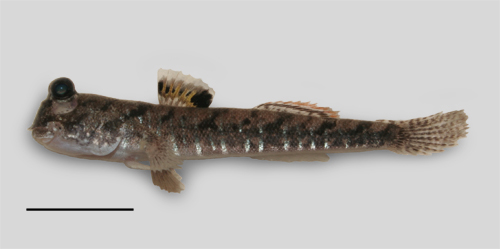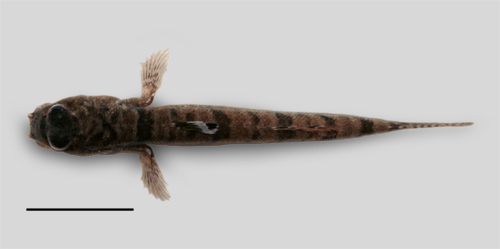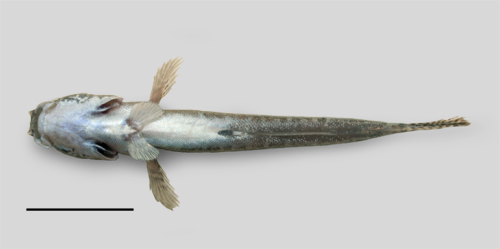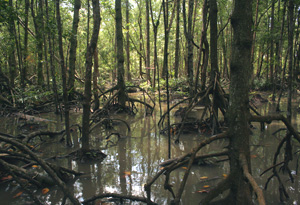Common names:
China |
Chinese Mandarin |
細彈塗魚,
细弹涂鱼 (Si tan tu yu - thin mudskipper) |
Italy |
Italian |
perioftalmo nano* |
Malaysia |
English |
Slender mudskipper* |
* proposed name
|
|
|
Synonyms:
Periophthalmus gracilis |
Eggert, 1935 |
(syn. senior, original combination) |
Etymology:
'Periophthalmus' is a compound name from the Greek 'peri' (around), and 'ophthalmôn' (eye), which refers to the wide visual field of these species
'gracilis' means 'slender' in Latin, which refers to the thinness of this mudskipper
|
Maximum recorded length:
45 mm SL (Murdy, 1989)
Live colouration (Murdy, 1989; pers. obs.: Peninsular Malaysia):
body ground colour dorsally and laterally light brown to grey, ventrally white; white irregular blotches on ventral side of head and vertical
iridescent bluish stripes on flanks; 5-7 diagonal, irregular saddle-like dark brown bars and irregular, smaller brown blotches on dorsum;
D1 membrane transparent, with a dusky inframarginal stripe and a large black
blotch posteriorly, covering the last 3-4 spines; in some specimens, one or more black spots are present between spines; D2 membrane transparent, with a series of grey spots proximally between elements, and an inframarginal dark stripe; caudal fin membrane and pectoral fins transparent, both with series of
dark speckles on rays; anal and pelvic fins white
In mature males, D1 is medially yellowish and D2 has a yellowish to reddish margin
Colouration on preservation (Murdy, 1989;
pers. obs.: Peninsular Malaysia, Indonesia):
ground colour light brown to greyish dorsally and laterally, white to yellowish ventrally; irregular dark saddle
bars and blotches usually present; D1 background transparent with a brown inframarginal stripe and
a large, black spot posteriorly; D2 background transparent with a brown
inframarginal stripe and dusky spots basally between elements; caudal and pectoral fins dusky with
series of brown speckles on rays; anal and pelvic fins white to yellowish
Diagnosis (Murdy, 1989; Jaafar et al., 2016):
D1 VI-XII; total elements of D2 11-13;
total elements of anal fin 11-13; longitudinal scale count 35-70; TRDB 14-20; head width 14.2-19.3%SL; pelvic fin length 11.7-15.1%SL;
length of anal fin base 17.8-21.1%SL; length of D2 base 18.8-21.3%SL; D1 with a dark inframarginal stripe and a large black spot posteriorly; pelvic fins with no frenum and no basal membrane uniting inner rays.
See Remarks for the discrimination between P. pusing and P. gracilis.
The genus is yet undefined by synapomorphies
Diet (Milward, 1974; pers. obs.: Peninsular Malaysia):
carnivorous, opportunistic (crustaceans, insects, etc.)
Reproduction:
the details of its reproductive
cycle have not been described: it probably follows the general model proposed for all
the congeneric species (see also Reproductive behaviour); no published study is available
|
|
Ecological notes (Polgar & Crosa, 2009):
locally abundant in mangrove forests through all the inlets' network; in the supratidal zone, at low tide this species can form dense aggregations of individuals at the water's edge of small tide pools, such as those dug by Periophthalmodon schlosseri on the bed of ephemeral tidal inlets.
P. gracilis can be ecologically partitioned between larger individuals, more abundant at lower levels in the mangrove forest (pioneer shore), and smaller ones, more abundant at higher levels (high forest); a similar pattern was observed in different habitats of the same ecosystem in Boleophthalmus boddarti and Oxuderces dentatus, while P. variabilis apparently exhibited an inverse pattern (Polgar & Bartolino, 2010)
left: Sementa, Selangor, Malaysia: low mangrove forest at low tide; a typical habitat of P. gracilis (photo: G. Polgar, 2006)
right: Kukup Is., Johor, Malaysia: high mangrove forest at high spring tide; also here this species is abundant (photo: G. Polgar, 2007)
|
|
|
|
|
Distribution:
Indo-Pacific region, from Sumatra to Philippines and Queensland, Australia; type locality: Java and Sumatra, Indonesia
(Murdy, 1989)
|
|
|
Remarks:
See Periophthalmus pusing.
Smaller specimens (SL 25-30 mm) of P. gracilis and P. pusing are not easily discriminated. Adults of P. gracilis can be discriminated from adults of P. pusing in having D1 with fewer spines (VI-XII in P. gracilis, XI-XV in P. pusing), shorter D1 (shorter or equal in height than D2 in P. gracilis, taller than D2 in P. pusing) and larger interdorsal distance (approximately equal to the length of the first D1 spine in P. gracilis, less than half the length of the first D1 spine in P. pusing) (Jaafar et al., 2016).
|
Photographs of Periophthalmus gracilis:
|
A: anesthetised female of P. gracilis
(photo: G. Polgar; Kukup Is., Peninsular Malaysia, 2007); B: an individual on the forest floor at low tide (photo: G. Polgar; Kukup Is., Peninsular Malaysia, 2007); C:
P. gracilis perching on an emerged root at high tide (photo: G. Polgar; Kukup Is., Peninsular Malaysia,
2007); D, E: other shots of P. gracilis perching at high tide (photo: G. Polgar; Kukup Is., Peninsular Malaysia, 2007); F: P. gracilis in a plastic bag; note the structure of the pelvic fins (photo: G. Polgar; Tg. Piai, Peninsular Malaysia,
2006); G: another close-up in a plastic bag; note the diagnostic posterior black blotch on D1 (photo: G. Polgar; Tg. Piai, Peninsular Malaysia,
2006);
H: a female in aquarium (photo: G. Polgar; Kukup Is., Peninsular Malaysia,
2007)
|
Drawings of Periophthalmus gracilis:
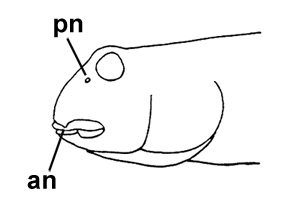
cephalic sensory and nasal pores of Periophthalmus spp.: an= anterior nostril; pn= posterior
nostril (modified from Murdy, 1989)* - * with permission
|




